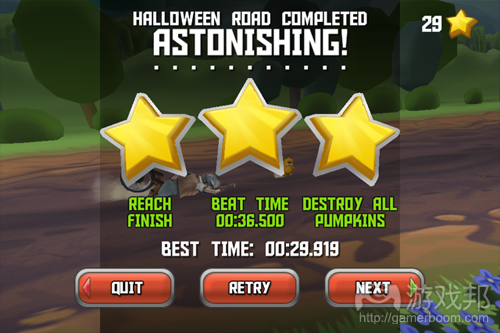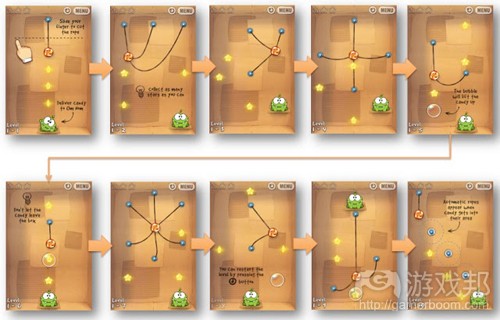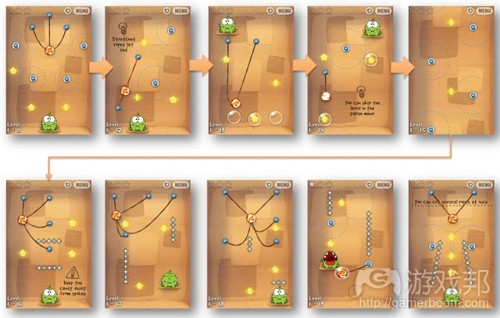总结设计玩家游戏初体验的5个技巧
作者:Michail Katkoff
对一款即将发布的游戏进行用户测试确实很困难,让我大开眼界。你总是发现玩家并没有按“应该”的样子玩那些相当简单、有益而有趣的关卡。为了保证玩家按照他们“应该”的样子玩你的游戏,你必须在玩家第一次玩游戏时就精心安排这个过程。
第一次玩游戏的经历是关键,因为玩家迷上游戏和学会游戏的核心循环都是在第一次游戏时发生的。最重要的是,你必须好好把握这个“第一次”,否则后面的关卡内容就全浪费了,因为玩家再也不会碰这款游戏了。
做了一天的用户测试,我总结出以下要点:
1、从剧情开始
你可以说我老土,但我确实喜欢在游戏中加入故事,因为可以给整个游戏某些确定的、有意义的东西,而不只是不经大脑的活动。这个故事可以通过一张图片、一段动画或视频讲述。只要不是用文本叙述的故事,我都觉得好。
2、一张图片胜过千言万语
你应该向玩家“展示”而不“描述”如何玩这款游戏。《植物大战僵尸》开发者George Fan认为,必要时只使用2个词,几乎不要超过8个词。所以不要再写游戏的指南了。没有人会阅读的!
3、教学:实践=1:2.5
基本上,当玩家第一次进入游戏时,游戏的首要任务就是向玩家显示自己的卓越之处和保证让玩家继续游戏。但另一方面,游戏还要趁机教会玩家如何玩。教玩家如何玩游戏是很容易出错的一个部分。
最常见的错误就是,教过头;也就是玩家一开始就被弹出窗口、聚光灯和文本连续轰炸。为了避免这种情况,你只需要把你希望玩家在第一次玩就能掌握的东西放在游戏初体验里,其他的则安排到后面的部分中。
根据我的经验,教学和实践的比率应该是1:2.5。例如(如下图所示),如果我想教会玩家射击,我会用一个让玩家射击聚光灯、浮动文本和箭头的关卡/任务作为开头。接着,我会安排2-3个关卡/任务(游戏邦注:取决于事件数据和玩家测试),让玩家在没有提示的情况下完成。之后,我将向玩家介绍其他游戏元素,还是让玩家在没有指导的情况下,利用刚才教授的知识完成2-3个关卡/任务。如果是一项补充技能,比如给枪装弹,你可以只安排一个教学任务再加一个综合任务,也就是让玩家利用刚刚学会的东西再加上之前学会的东西完成操作。
(关卡顺序是:1个教学关卡–2-3个实践关卡–1个教学关卡–1个综合关卡。)
4、星星(成就系统)
星星通常用于评价玩家在某个关卡中的表现情况,以激励玩家再接再厉。用星星鼓励玩家追求极致当然不错,但这不是星星的唯一用法。
星星还可以用来吸引和留住甚至那些玩得不太好的玩家。你要做的就是,让玩家非常轻易就能拿到1颗星(游戏邦注:至少在第一轮关卡/任务中),以确保玩家不会因为觉得游戏难度太大而跑路。同时,那些玩得好的玩家可以在3颗星的刺激下追求更好的表现。
换句话说,星星系统应该与关卡设计相结合:一方面,新玩家不会被某个关卡难住;另一方面,老玩家又觉得有挑战性。
案例可以参考《摩托男爵》或《切绳子》(见下文)。
5、事件数据
最后,保证你收集到正确的事件数据。知道新玩家第一次游戏时,在什么时候、以什么方式、必须完成多少关卡/任务。玩家的游戏初体验总是有进一步提升的空间,你要做的就是显示数字。另外,你应该避免所有关于人们“觉得”如何玩游戏和人们“认为”什么可能是问题的讨论。只要给他们看数字!
案例:《切绳子》
我很喜欢Zeptolab在《切绳子》中设计的指导玩家游戏的方式。游戏首先通过一段简短而精致的动画向玩家介绍游戏的主角Om Nom,它被装在一口箱子里,放在教授家门口。这3秒钟的介绍动画播放完毕后,玩家就正式开始游戏了。
第1关是一个简单的介绍关卡,玩家从中可以知道如何切绳子和得到3颗星星。第2关的难度稍大,因为绳子数量多了,很难把3颗星都拿到。到了第5关,游戏引入新元素——泡泡。 泡泡介绍完后的4个关卡都没有指导,直到新机制出现。
《切绳子》做得最好的地方是,充分利用了星星系统。得到一颗星星就能进入下一关,非常简单,所以不存在卡进度的问题。同时,游戏又对玩家提出挑战,刺激他们想方设法拿到所有的3颗星星。
前面4个关卡很简单,都是切绳子。第5关引入泡泡。第10关又新加入自动连绳机制。
第12关引入弹性绳机制,而第16关第一次出现蜘蛛,第20关玩家学会如何同时切断几根绳子。
第22关教玩家多重接触,第25关很简单,玩家基本上可以拿到3颗星星。
逐关分析:
1、超级简单关卡,稳拿3颗星星。用一根动画手指教玩家如何切绳子。
2、同样的动作,只是没有动画手指了。超级容易通关,但不能保证一次性拿到3颗星星。文本建议玩家收集尽可能多的星星。
3、超级简单的关卡,没有提示文本。
4、简单的关卡。没有新元素。
5、引入泡泡概念。
6、引入泡泡爆炸的概念。
7、回到基础关卡。没有泡泡,也没有提示,只有绳子。
8、泡泡关卡。教玩家按重新开始按钮。
9、又是基础关卡,有泡泡和绳子。
10、引入自动连绳机制。
11、自动连绳关卡。没有提示,也没有说明。
12、引入弹性绳的概念。
13、回到正常的关卡,有泡泡和基础绳。
14、告诉玩家可以从暂停菜单跳过关卡。
15、第一个大关卡,玩家看不到小绿怪。摄像机将玩家从目标引向起点。
16、引入蜘蛛。
17、有蜘蛛的关卡。
18、没有蜘蛛的关卡。
19、引入限时机制。玩家必须在蜘蛛吃掉糖果以前将糖果送进小绿怪口中。
20、告诉玩家可以同时切断若干绳子。
21、需要同时切断若干绳子的关卡。
22、引入多重接触。
23、要求多重接触的关卡。
24、弹性绳关卡。玩家的速度要够性。
25、最后一关。很容易拿到3颗星星,为下一轮关卡开个好头。(本文为游戏邦/gamerboom.com编译,拒绝任何不保留版权的转载,如需转载请联系:游戏邦)
5 Points for Killer First Time Flow
by Michail Katkoff
User testing a title getting ready for the launch is a really tough and truly an eye opening experience. Every single time. You’ve constructed all these really simple, educating and fun levels just
to realize that players don’t play the game as they were ‘supposed to’. To ensure that your game is played like it is supposed to you need to have a killer first time flow.
First time flow hooks the players and teaches them the core loop of the game. Most importantly, you have to kill it with the first time flow because if it sucks all the content done for the later
levels will be left untouched.
After a day spent with user tests, here are my points for a killer first time flow:
1. Start off with a story
Call me old fashioned but I really like a story to my games. It just give that certain something to the whole game. A meaning instead of a mindless activity. The story can be told with a single
image, cartoon or a video. As long as it’s not a text, I’m cool with it.
2. Image = 1000 words
You should always show players how to play the game instead of telling it to them. George Fan, creator of Plants vs. Zombies believes in using only two words when needed and goes up to 8 words on rare occasions (10 tutorial tips from Plants vs. Zombies creator George Fan). So stop writing instructions. Nobody reads them!
3. 1 teach mission = 2.5 do missions
Essentially first time flows are all about showing how cool and awesome your game is and will be if the player just continues playing. But on the other side first time flows are also about teaching your players how to play the game… and teaching is the part where it tends to go wrong.
Most common mistake is to over teach. You know, when you’re bombarded with popups, spotlights and texts right from the start. To avoid this you just need to simply cut the things you want to teach the player on their first time flow and leave it to later levels.
My rule of thumb is to have a conversion rate of 2.5 between teaching and doing. For example (picture below) if I want to teach the player to shoot, I’ll start of with a level/mission where player is taught how to shoot with a spotlight, a floating text and an arrow or two. Then I will follow up the teaching level/mission with 2 – 3 (depending on event data and user tests) following levels/missions where players have to do what they are told to but without any hints. After the follow-up missions I’d go and teach another element of the game and follow it up again with 2 – 3
levels/missions where players don’t get any instructions and just do what they were just taught. Or in case it is a complementary skill, say reloading a gun, you can have only one teaching mission followed by a combination mission, where players have to do what they were just taught to do plus what they were doing beforehand.
One teaching level followed by 2 – 3 doing levels followed by an another teaching level and a combination level.
4. Stars
Stars are often used just to show how well players did on a particular level and to challenge them to best the level with a perfect performance. Now this challenge to perfection is a great thing,
but it’s not the only way you can use stars.
Stars are great for keeping your funnel in check and keeping even those not-so-good players progressing from one level to another. What you need to do is make the 1 star performance really truly easy (at least during the first dozens of levels/missions) just to ensure that players don’t drop off because the game is too hard for them. At the same time those good-players can be challenged to perfect their performance by getting 3 stars.
In other words, star system should be tied with level design so that levels don’t block the progress of unexperienced players while providing a true challenge for the experienced players.
Want an example?
Check out Bike Baron or Cut the Rope case on the bottom of this page
5. Event data
And finally make sure you’re collecting the right event data. Knowing when, how and how many complete levels/missions is essential for a successful first time flow. There’s always room to improve the first time flow and numbers is what you need to get there. Plus you’ll avoid all the discussion about how people ‘feel’ the game is played and what they ‘think’ might be the problem. Numbers.
Give ‘em numbers!
Case: Cut the Rope
I love the way Zeptolab’s Cut the rope teaches and hooks players with the first level pack of 25 awesome levels. They start off with a nice quick animation of Om Nom (green main character) being left in a box in front of the professors door and after this 3 second long story introduction player is set off.
The first level is simple instructive level where player learn how to cut the rope and gets 3 stars. The second level is just a bit harder introducing multiple ropes and challenging player to get 3
stars. And it goes like this till level 5 where a new element, bubble, is introduced. After introducing the bubble there are 4 follow up missions with little to none instructions till a new feature
is introduced once again.
What’s best about Cut the Rope’s progress is the way they use the star system. It’s really easy to get the one star and progress to the next level, so there are no progression blocks. At the same time the game challenges you to come up with a way to get all of the 3 stars.
Check out the progression flow below and try the game on a browser: http://www.cuttherope.ie/
The first four levels are just simple cutting of the rope. Fifth level introduces the bubbles. Tenth level mixes it up by introducing automatic ropes.
Twelfth level introduces stretched ropes while on sixteenth level player encounters the spikes for the first time. Twentieth level teaches player to cut several ropes with one brush.
Twenty-second level teaches the multi-touch. Twenty-fifth level is easy one and basically guarantees a three star ending.
Level by level breakdown:
1.Super easy 3 star level. Teach cutting the rope with animated finger.
2.Now the same thing without animated fingers. Super easy to pass but might take a restart to get the 3 stars. Text suggests to collect as many stars as player can.
3.Super easy level with no hint texts.
4.Easy level. Nothing new.
5.Introducing the bubble concept.
6.Introducing the bursting of a bubble concept.
7.Back to basics. No bubbles, no hints. Just ropes.
8.Bubble level. Teaching player to press on the restart button.
9.Again basic level with a bubble and ropes.
10.Introducing automatics ropes.
11.Level with automatics ropes. No hints or instructions.
12.Introducing stretched ropes.
13.Back to normal level design with bubbles and basic ropes.
14.Tell the player that they can skip levels from the pause menu.
15.First BIG level where player can’t see Om Nom. Camera takes the players from the goal to the starting point.
16.Introducing spikes.
17.Level with spikes.
18.Again level with spikes.
19.Introducing timed levels. Player has to make the move as the level starts with the candy in motion heading towards the spikes.
20.Teaching players that they can cut several ropes with one brush.
21.Continuing with cutting several ropes with one brush.
22.Teaching multi-touch.
23.Level wich demands multi-touch.
24.Level with stretched ropes. Demands some speed from the players.
25.Final level. Easy to get 3 stars. Good start for the following level pack. (source:deconstructoroffun)
下一篇:阐述打造游戏品牌的5个关键要素














































 闽公网安备35020302001549号
闽公网安备35020302001549号